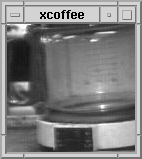20th anniversary of the webcam
 This story describes how the webcam got invented. A small idea grown during
This story describes how the webcam got invented. A small idea grown during
the question on how full a coffee machine’s can in a distant office room is.
Quentin Stafford-Fraser picked up the idea to remotely watch the coffee can by
a camera pointing to the coffee machine shooting a picture every 20 seconds.
The idea was initially only available for the campus members of Cambridge University as the software could send the pictures only via network. The internet was still in it’s basics and webbrowsers were not able to display pictures yet.
Here’s the full story on how the webcam was born in 1991 and how it changed today’s communication between each other.
The Trojan Room Coffee Pot
A (non-technical) biography
by Quentin Stafford- Fraser
Several people have asked about the origins of the Trojan Room coffee pot. It started back in the dark days of 1991, when the World Wide Web was little more than a glint in CERN’s eye. I was working on ATM networks in a part of the Computer Lab known as the Trojan Room, (a name which, perhaps, causes some amusement to American readers). There were about fifteen of us involved in related research and, being poor, impoverished academics, we only had one coffee filter machine between us, which lived in the corridor just outside the Trojan Room. However, being highly dedicated and hard-working academics, we got through a lot of coffee, and when a fresh pot was brewed, it often didn’t last long.
Some members of the ‘coffee club’ lived in other parts of the building and had to navigate several flights of stairs to get to the coffee pot; a trip which often proved fruitless if the all-night hackers of the Trojan Room had got there first. This disruption to the progress of Computer Science research obviously caused us some distress, and so XCoffee was born.
 In the Trojan Room there were several racks of simple computers used in the testing of our networks. One of these had a video frame-grabber attached and was not being used at the time. We fixed a camera to a retort stand, pointed it at the coffee machine in the corridor, and ran the wires under the floor to the frame-grabber in the Trojan Room. Paul Jardetzky (now working in California) then wrote a ‘server’ program, which ran on that machine and captured images of the pot every few seconds at various resolutions, and I wrote a ‘client’ program which everybody could run, which connected to the server and displayed an icon-sized image of the pot in the corner of the screen. The image was only updated about three times a minute, but that was fine because the pot filled rather slowly, and it was only greyscale, which was also fine, because so was the coffee.
In the Trojan Room there were several racks of simple computers used in the testing of our networks. One of these had a video frame-grabber attached and was not being used at the time. We fixed a camera to a retort stand, pointed it at the coffee machine in the corridor, and ran the wires under the floor to the frame-grabber in the Trojan Room. Paul Jardetzky (now working in California) then wrote a ‘server’ program, which ran on that machine and captured images of the pot every few seconds at various resolutions, and I wrote a ‘client’ program which everybody could run, which connected to the server and displayed an icon-sized image of the pot in the corner of the screen. The image was only updated about three times a minute, but that was fine because the pot filled rather slowly, and it was only greyscale, which was also fine, because so was the coffee.
This system only took us a day or so to construct but was rather more useful than anything else I wrote while working on networks. It also made a better topic of conversation at dinner parties than ATM protocols. The first published record of XCoffee came when Bob Metcalfe wrote about it in Comm Week on 27th January 1992 after visiting the lab, and inspired by this success, there was talk of other monitoring applications using low-frame-rate video. Systems such as XSandwichVan and XPrinterOutputTray were mooted, but the elderly frame grabber eventually gave up the ghost, Paul and I moved on to other things, and the Trojan Room coffee pot would have sunk into obscurity had not Daniel Gordon and Martyn Johnson resurrected the system, treated it to a new frame grabber, and made the images available on the World Wide Web. Since then, hundreds of thousands of people have looked at the coffee pot, making it undoubtedly the most famous in the world.
I don’t think the coffee’s any better, though.
Quentin Stafford-Fraser
It is for sure an interesting story as I got in touch with such technology in early 1996 when webcams were rather expensive and the pictures of poor quality, despite the fact that Windows 95 tended to crash several times until you could send a standalone-EXE with the video file inside over the internet.
Ten years later, the server with the webcam attached got shut down with this last picture taken:

Those were the times…
P.S.: It seems as if Spiegel Online has purchased the machine for a price of approx 10.000 EUROS and let it live on again:









 Users Today : 496
Users Today : 496 Users Yesterday : 348
Users Yesterday : 348 This Month : 12613
This Month : 12613 This Year : 169897
This Year : 169897 Total Users : 1034192
Total Users : 1034192 Views Today : 2333
Views Today : 2333 Total views : 4072162
Total views : 4072162
Leave a comment